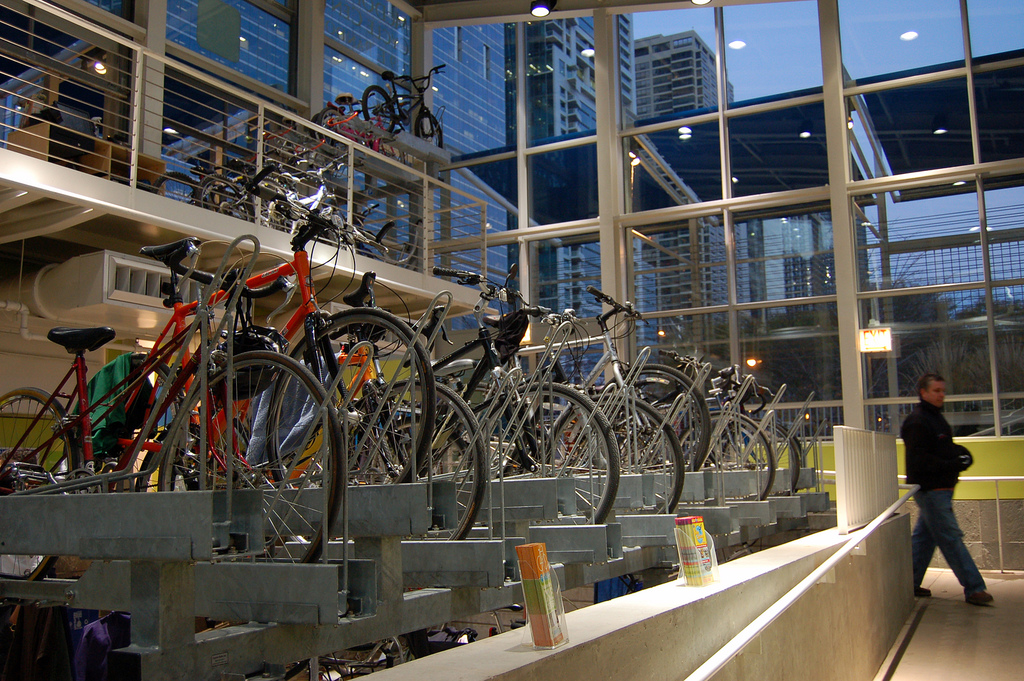Mobility, whether on two wheels, four wheels, or more, is on the minds of multifamily developers and designers, according to a recent survey of 215 architects, designers, builders, and developers in the U.S./Canada multifamily construction sector, by Multifamily Design + Construction, a BD+C sister publication.
The need of bicyclists for secure storage is being met by two-thirds of respondents (66.5%); about one-third (31.7%) are providing repair and maintenance services in so-called “bicycle kitchens,” while one-fifth (20.4%) said they’re offering bike sharing. A similar cluster (19.0%) said they’re providing car-share services (e.g., Zipcar).
A remarkable number of respondents (17.6%) said they have created waiting areas for shared-rise services (Uber, Lyft), but these may just lobbies or other weather-protected areas.
A substantial group, about two-fifths (39.4%), have built “within a short walk” of bus or rail transit.
Look for the full report in the Fall (October) issue of Multifamily Design+Construction.
Mobility amenities in multifamily developments:
Bicycle Storage (secured): 66.5%
Electric Vehicle Charging Station: 42.0%
Transit Access: 39.4%
Bicycle Repair/Maintenance: 31.7%
Bicycle Sharing: 20.4%
Source: Multifamily Design + Construction Reader Survey, June-July 2017
Related Stories
Green | Jan 10, 2022
The future of regenerative building is performance-based
Why measuring performance results is so critical, but also easier said than done.
Senior Living Design | Jan 5, 2022
Top Senior Living Facility Design and Construction Firms
Perkins Eastman, Kimley-Horn, WSP USA, Whiting-Turner Contracting Co., and Ryan Companies US top BD+C's rankings of the nation's largest senior living sector architecture, engineering, and construction firms, as reported in the 2021 Giants 400 Report.
Giants 400 | Jan 3, 2022
2021 Government Sector Giants: Top architecture, engineering, and construction firms in the U.S. government buildings sector
Stantec, Jacobs, Turner Construction, and Hensel Phelps top BD+C's rankings of the nation's largest government sector architecture, engineering, and construction firms, as reported in the 2021 Giants 400 Report.
Architects | Dec 20, 2021
Digital nomads are influencing design
As our spaces continue to adapt to our future needs, we’ll likely see more collaborative, communal zones where people can relax, shop, and work.
Architects | Dec 17, 2021
What I wish I had learned in architecture school
Bradford Perkins, FAIA, offers a 3-point plan for upgrading architecture education.
Urban Planning | Dec 15, 2021
EV is the bridge to transit’s AV revolution—and now is the time to start building it
Thinking holistically about a technology-enabled customer experience will make transit a mode of choice for more people.
Sports and Recreational Facilities | Dec 15, 2021
Trends in sports stadium construction, with Turner Construction's Dewey Newton
Turner Construction's Dewey Newton discusses trends in sports stadium renovation and construction with BD+C's John Caulfield. Newton is a Senior Vice President who heads up Turner Construction’s Sports Group.
Healthcare Facilities | Dec 15, 2021
COVID-19 has altered the speed and design of healthcare projects, perhaps irrevocably
Healthcare clients want their projects up and running quicker, a task made more complicated by the shortage of skilled labor in many markets.
Healthcare Facilities | Dec 15, 2021
MEP design considerations for rural hospitals
Rural hospitals present unique opportunities and challenges for healthcare facility operators. Oftentimes, the infrastructure and building systems have not been updated for years and require significant improvements in order to meet today’s modern medical demands. Additionally, as these smaller, more remote hospitals are acquired by larger regional and national healthcare systems, the first step by new ownership is often to update and rehabilitate the building. But how can this be done thoughtfully, economically, and efficiently in ways that allow the engineering and facility staff to adapt to the changes? And how can the updates accurately reflect the specific needs of rural communities and the afflictions with which these areas most commonly face?
Architects | Dec 13, 2021
Dan Hart, FAIA, inaugurated AIA 2022 President
Dan Hart will be the AIA's 98th President.

















